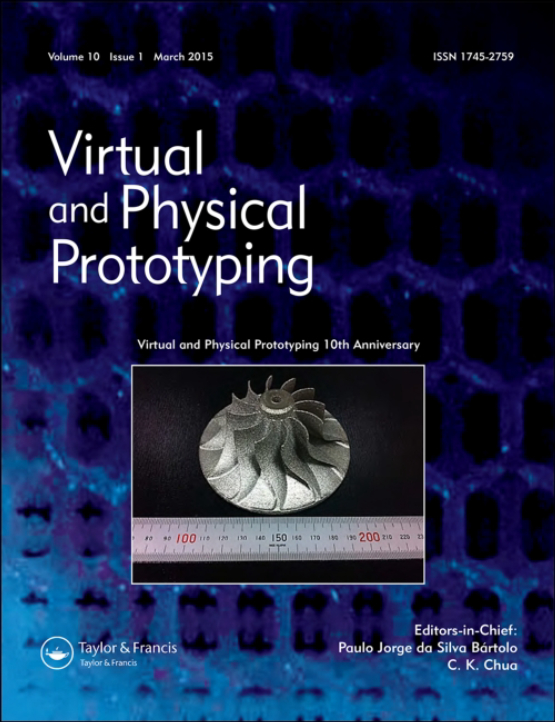Submit a Manuscript to the Journal
Virtual and Physical Prototyping
For an Article Collection on
3D and 4D Printing of Architected Biomaterials
Manuscript deadline


Article collection guest advisor(s)
Dr. Mehrshad Mehrpouya,
University of Twente (UT)
m.mehrpouya@utwente.nl
Prof. Henri Vahabi,
University of Lorraine- France
henri.vahabi@univ-lorraine.fr
3D and 4D Printing of Architected Biomaterials
The field of biomaterials has witnessed significant advancements with the advent of 3D and 4D printing technologies, revolutionizing the design and development of architectured biomaterials for a wide range of biomedical applications. This allows for precise control over their architecture and functionality, enabling the creation of complex and tailored structures. 3D-printed biomaterials promote cell proliferation, tissue integration, and nutrient transport, closely mimicking the extracellular matrix for enhanced tissue regeneration; moreover, drug delivery systems offering controlled release profiles and targeted delivery mechanisms, which are crucial for effective therapeutic interventions. The advent of 4D printing introduced a dynamic dimension, allowing biomaterials to change their properties over time in response to environmental stimuli such as temperature, pH, or magnetic fields. This innovation holds promise for creating smart scaffolds that can evolve alongside the healing process, optimizing tissue regeneration and functional recovery, and widening innovation avenues for designing biomaterials with tuneable properties for personalized medicine.
This article collection will focus on "3D and 4D Printing of Architected Biomaterials" to combine cutting-edge and novel approaches and insights into the development, design, and application of advanced printing techniques for realizing and personalizing architected biomaterials. The 3D and 4D printed architected biomaterials mimicking biological tissues, enhancing tissue integration, and improving drug delivery systems are at the core of this collection. By collecting high-impact studies, this article collection bridges the gap between fundamental research and practical applications, showcasing how these technologies are transforming fields such as regenerative medicine, biomedical engineering, and therapeutic delivery. Another key objective is to explore the dynamic possibilities of 4D printing, where time introduces a programmable dimension. This collection highlights the use of stimuli-responsive biomaterials that can adapt to environmental triggers like temperature, pH, or magnetic fields. Such adaptability is essential for next-generation biomaterials designed for applications including wound healing, tissue engineering, and implantable devices.
This article collection aims to inspire new research directions and technological advancements to foster interdisciplinary collaboration, inviting contributions from researchers, clinicians, and engineers to address challenges in creating precision-based, personalized healthcare solutions. This collection aspires to be a reference point for academics, industry researchers, and practitioners, driving the integration of 3D and 4D printing technologies in the design of architected biomaterials for diverse applications. The types of papers include but are not limited to Original Papers, Letters to the Editor, Review Papers, Short Communications, and Mini-Reviews, emphasizing innovative 3D and 4D printing techniques, stimuli-3D and 4D printed responsive biomaterials with tailored architectures such as temperature-, pH-, and light-responsive ones, and implantable and transplanted biomaterials with the goal of driving innovation and integration into clinical practice for improved outcomes. The targets are among enhanced mechanical properties and adaptability, porous stimuli-responsive biomaterials for biomedical implants, biological sensors, and other innovative structures thereof.
Keywords: Additive Manufacturing; 3D Printing; 4D Printing; Architected structures; Biopolymers
All manuscripts submitted to this Article Collection will undergo a full peer-review; the Guest Advisor for this Collection will not be handling the manuscripts (unless they are an Editorial Board member).
Please review the journal scope and author submission instructions prior to submitting a manuscript.
The deadline for submitting manuscripts is [30 September 2025].
Please contact [Zhan Yu] at [zhan.yu@taylorandfrancis.com] with any queries and discount codes regarding this Article Collection.
Please be sure to select "3D and 4D Printing of Architected Biomaterials" from the drop-down menu in the submission system.
Dr. Mehrshad Mehrpouya is an Assistant Professor in the Department of Design, Production, and Management (DPM) at the University of Twente. In this role, he leads the research domain of Smart Materials and Structures (SMART) as part of the AMSPES research chair.
He earned his Ph.D. through a prestigious fellowship program at Sapienza University of Rome, Italy, in 2017. His doctoral and postdoctoral research, conducted between 2014 and 2019, focused primarily on the advanced manufacturing of shape memory materials. During this time, he developed a range of experimental and simulation methods for laser welding and additive manufacturing processes.
Throughout his career, he has been actively involved in numerous European and National projects, such as REDI, Smart Sandwich, reSHAPE, and Waste2Print. Additionally, he has organized a scientific webinar on the advanced manufacturing of smart materials and structures.
Prof. Henri Vahabi has been active in the field of Polymer Science and Technology for over 15 years. He earned his Ph.D. from the University of Montpellier, France, in 2011, followed by his Habilitation in 2018. His research currently focuses on the development of advanced materials using various manufacturing techniques, including additive manufacturing. Prof. Vahabi has authored or co-authored around 180 peer-reviewed articles in high-impact journals and 3 books. In 2023, he co-authored with Dr. Mehrpouya a book titled “Additive Manufacturing of Biopolymers”. He serves as Associate Editor of Polymers from Renewable Resources Journal.
Benefits of publishing open access within Taylor & Francis
Global marketing and publicity, ensuring your research reaches the people you want it to.
Article Collections bring together the latest research on hot topics from influential researchers across the globe.
Rigorous peer review for every open access article.
Rapid online publication allowing you to share your work quickly.
Submission Instructions
All manuscripts submitted to this Article Collection will undergo desk assessment and peer-review as part of our standard editorial process. Guest Advisors for this collection will not be involved in peer-reviewing manuscripts unless they are an existing member of the Editorial Board. Please review the journal Aims and Scope and author submission instructions prior to submitting a manuscript.
